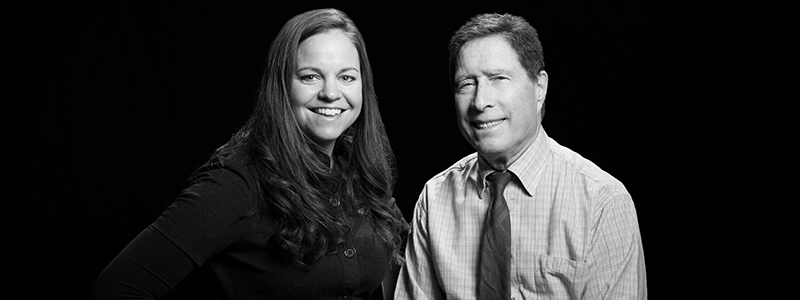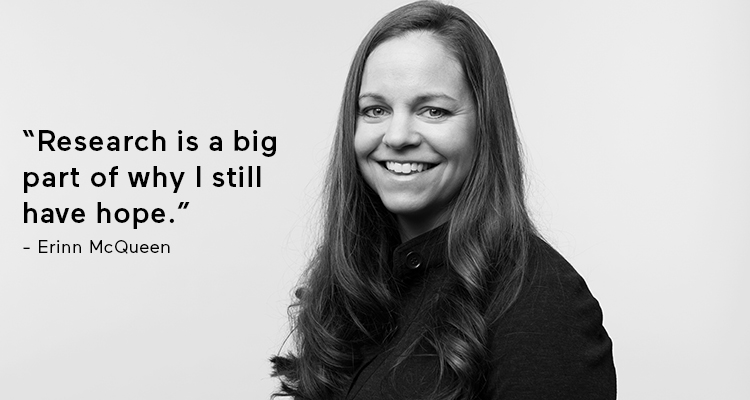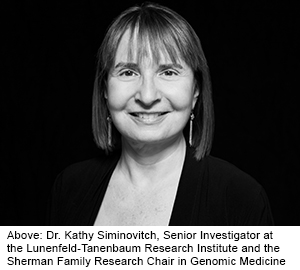
 Above: Erinn has been a patient of Dr. Edward Keystone for nearly 20 years
Above: Erinn has been a patient of Dr. Edward Keystone for nearly 20 years
Written By:Veronika Izabela Bryskiewicz
Photos By: John Packman
Less than half a century ago, a diagnosis of rheumatoid arthritis was like a premature death sentence. It meant a life of restricted movement, disfigurement, severe chronic pain and hospitalization.
Back then, no one knew that it was actually an illness of the immune system — an immune system that, due to an imbalance triggered by genetics and the environment, became over-reactive and attacked itself. In the case of rheumatoid arthritis: a merciless attack on the tissues lining the joints.
Gold injections, which dampened the symptoms of disease for a short period of time, were then part of the gold standard of care, though doctors did not understand why they worked, nor did the injections stop the disease’s progression for most patients.
But since then, knowledge about the illness has come a long way. In the last two decades alone, an explosion of clinical trials has led to a broader array of medications that keep symptoms and disease progression at bay.
Perhaps what is most exciting is the potential of some of the research taking place at Sinai Health System to not only help match the right drug to the right patient, but to someday stop the disease from ever manifesting in those who are at greatest risk.
Erinn McQueen is one of many rheumatoid arthritis patients who thrives for a period of time on a medication, but for reasons unknown, reaches a point when the same medication eventually ceases to work.
A patient at Sinai for 17 years, her journey began at age 21 when she was a star player on her university’s varsity soccer team. All of a sudden, she felt chronically exhausted and in pain. After several misdiagnoses, she was finally diagnosed with rheumatoid arthritis, thanks to a test that recognized a known biomarker in her blood, which shows up in about 70 per cent of cases.
As her illness progressed over the last decade and a half, she has had to change medications five times. At her worst, she was unable to brush her own hair or tie her own shoes, and she had to undergo several surgeries to remove damaged and disfigured joints, including a hip replacement in her early 30s.
But for a period of time in her late 20s, her illness entered into what is called a “remission state,” where her symptoms completely disappeared and she was able to go drug free long enough to have two healthy pregnancies. These drug-free remission states, although they can happen, are rare. More often, patients have what doctors call “low disease states,” where symptoms are kept at bay via medications.
For Erinn, knowing that researchers are working on groundbreaking new treatments continues to give her hope about her future.
One of the first things Dr. Edward Keystone said to Erinn when he became her rheumatologist nearly two decades ago was: “I will make you better.”
Dr. Keystone, Director of The Rebecca MacDonald Centre for Arthritis and Autoimmune Disease (RMCAD), has always seen it as his role as a doctor to help improve people’s health. He vividly remembers his first job at the now-closed Wellesley Hospital in the 1970s. It was a time when rheumatoid arthritis patients were hospitalized and there was almost nothing that medicine could do for them.
Today doctors know that the disease is driven by inflammation-causing hormones that are released by the body’s immune cells — likely triggered by something in a person’s environment like bacteria, a virus or lifestyle factors such as smoking. The immune system normally protects the body from foreign invaders, but in autoimmune conditions, for unknown reasons, the immune system also attacks the body’s own tissues.

A new family of drugs that has emerged in the last 15 years called “biologics” has dramatically changed the landscape. Biologics — a class of protein-based drugs derived from living cells — act like targeted missiles that remove the inflammation-causing hormones from circulating in a person’s body. With the hormones gone, symptoms subside, and debilitation is halted in its tracks.
“As no two faces are the same, so no two bodies are alike, and no two individuals react alike and behave alike under the abnormal conditions which we know as disease.”
- Sir William Osler (1849-1919)
But only a small percentage of patients are able to stay on the same biologic long term. At the other end of the spectrum, for about 15 per cent of patients, none of the drugs available to date has ever worked. For the remaining patients, like Erinn, medication-hopping is the norm.
Even amidst our current technological advancements, picking the right medication for a patient is trial and error. “It’s like tossing a coin,” says Dr. Keystone. “Right now, there is no simple test that can tell us which medication is best for each individual patient. But with the research discoveries we are making today using precision, or personalized, medicine, I believe we will be able to do that within the next decade.”
One of the many initiatives Dr. Keystone is a part of is outcomes research. With funding from the National Institutes of Health in the U.S., RMCAD is one of several centres following thousands of patients who researchers know are genetically susceptible to getting the disease based on genetics or biomarkers. To see if it is possible to eradicate the disease before onset, people who are not yet sick will be treated with medication. If the research proves successful, it will be a huge step forward for the promise of precision medicine — treating patients earlier, and more effectively.
But for those patients who are too far along with their illness to be treated this way, precision medicine can provide another beacon of hope.
Sir William Osler, the father of modern medicine, once said: “As no two faces are the same, so no two bodies are alike, and no two individuals react alike and behave alike under the abnormal conditions which we know as disease.” This observation is a major focus of scientist Dr. Kathy Siminovitch’s research. Dr. Siminovitch, who is a Senior Investigator at the Lunenfeld-Tanenbaum Research Institute and the Sherman Family Research Chair in Genomic Medicine, has already discovered many of the key genetic variants (mutations and abnormalities) that cause rheumatoid arthritis. Much of her recent work is focused on understanding the mechanisms of how an individual’s own genetic makeup causes a different manifestation of the same illness.
“To understand why patients have different responses to medications and to disease, we need to define their genetic and immunologic differences,” she says. “With this knowledge, we can start to define what the predictive biomarkers are for these variable outcomes.”
 In collaboration with scientists at the University of Toronto and Hospital for Sick Children, Dr. Siminovitch’s lab team has established a Centre for Immune Profiling and is capitalizing on new technology to search for genetic and immune cellular biomarkers that can be used to tailor, and optimize, treatment for individual patients.
In collaboration with scientists at the University of Toronto and Hospital for Sick Children, Dr. Siminovitch’s lab team has established a Centre for Immune Profiling and is capitalizing on new technology to search for genetic and immune cellular biomarkers that can be used to tailor, and optimize, treatment for individual patients.
Results of this research will help clinicians like Dr. Keystone match the right drug to the right patient at the right time. Which also means it will help patients like Erinn mitigate painful joint damage in the long run.
“Eventually,” says Dr. Siminovitch, “we want to cure people.”
For Erinn, rheumatoid arthritis has changed her entire life.
Though she has had to abandon some of her earlier dreams, like playing sports competitively or pursuing a career in massage therapy, she remains optimistic about what she still can do. These days, it includes coaching her daughter’s basketball team and working to become a certified Pilates instructor. She is also a patient advocate, and speaks publicly about her experience with the illness.
“Things that were easy before my diagnosis, like climbing stairs or riding my bike, became very difficult,” she says. “Ongoing research into new treatments has allowed me to enjoy these activities again, and I’m determined to live each day as best as I can. Research is a big part of why I still have hope.”